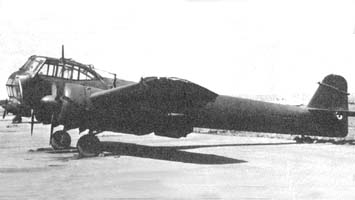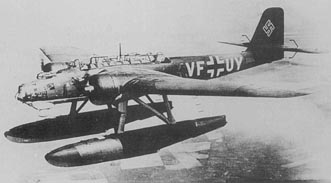Indeed excellent explorative work, honorable ladies and gentlemen. I shall try to throw in here some additional details.
Firstly, it has to be accentuated that the most successful German torpedo-bomber in WW2 without a shred of doubt was a good old He 111, and the most enviable results of this type have been achieved through combat actions that were undertaken from Bardufoss and Banak airfields in Norway - predominantly by KG 26 (Löwen Geschwader) - against allied convoys plying the North Cape route from mid-June 1942 onwards.

He 111 H-6, KG 26, equipped with two Lufttorpedo LF 5B
Although slightly outdated, the He 111 possessed some very good flight characteristics. First of all, old “Doppel-Blitz” (double lightning) was a steady machine, unwavering in level flight, completely predictable within cruise regime, with a possibility to be smoothly trimmed, as well as with quite handy low-level cornering speed. The plane was initially designed to be an unyielding bombing platform and its behavior has completely reflected that assignment.
He 111H-6 produced from late 1941 was the first torpedo-variant of the type able to carry heavy external loads, including bombs larger than 250 kg, or a pair of torpedoes, beneath the fuselage. The He 111H-6 was both versatile and well liked by its crews, serving on all fronts with the Luftwaffe.

He 111 H6 Torpedo-bomber
Potentials of air-launched torpedoes, however, were discovered commensurately very late, because the German torpedo development had been completely in the hands of the Kriegsmarine since 1932, which had actually purchased the Horten naval torpedo patents from Norway in 1933 and the Whitehead-Fiume patents from Italy in 1938. Germans, essentially, had used a variant of the Norwegian aircraft-dropped torpedo – the 450mm Schwarzkopf F5 with a range of 2000 meters and maximum speed of 33 knots. It was armed with a 200 kg Hexanite explosive warhead. Subsequent German derivative, improved LF 5B travelled at a speed of 40 knots, and was armed with a 180 or 250 kg warhead filled also with Hexanite.
It has to be maentioned, however, that the technical development toward German air-launched torpedoes was pursued in a rather leisurely manner, mainly bcause it was conducted by the Seeluftstreitkrafte (naval air division of the Kriegsmarine), and the results of trials and reports of combat operations were jealously guarded by the navy. During extensive torpedo-dropping trials, carried out in 1939, both the He 59 and He 115 floatplanes were used, and the failure rate of the torpedoes was a amazing 49 percent!
In 1941, the Luftwaffe decided to pursue its own development trials with the intention of setting up a powerful force of torpedo-bombers. The first torpedo development establishment was formed at Grossenbrode, on the Baltic coast. Several aircraft types were intensively tested and it was soon apparent that the proven and long-established He 111, as well as the faster Ju 88 were the most suitable types.

He 111 H 6 – LF 5b launch
Luftwaffe unit Kampfgeschwader 26 was anticipated to play the leading role in this new torpedo plan, and Stab, I and III/KG 26 were selected as the specialized torpedo-units, while II/KG 26 remained in the classicist level-bomber role. It sounds almost unbelievable, but the tactical detachment of a few of KG 26’s He 111s to Flieger Korps X in the autumn of 1941 for torpedo operations was short-lived due to lack of torpedoes!
In January 1942, the Luftwaffe’s demands for the centralization and control of all German and Italian torpedo development were finally granted. Colonel Martin Harlinghausen was appointed as the head of all Luftwaffe torpedo development, supply, training and operational organizations, with the TorpedoTraining School established at Grosseto in Italy. During the early months of 1942, I/KG 26 underwent torpedo conversion-courses, lasting between three and four weeks. The Gruppe’s He-111H-6’s could carry two torpedoes slung on racks beneath the belly; the standard torpedoes used were the German LT F5 and LT F5W, both of 450-mm caliber, with the latter based on the Italian model made by Silurificio Whitehead di Fiume.
While I/KG 26 underwent conversion at Grosseto, its future and the bases from which it would operate had already been decided. Luftflotte V, based in Norway and Finland, needed additional bomber support to interdict Allied convoys on the Murmansk/Archangelsk route. In March, Göring ordered Luftflotte V to collaborate with the aerial reconnaissance units of the Kreigsmarine and to attack the convoys when they came into range, and also to shift bomber forces from the Finnish front to accomplish this task. Within I/KG 26, based at Banak and Bardufoss, there were 12 crews available for torpedo operations with the Heinkel He 111H-6 planes.
During March and April, various PQ [and retuning QP] convoys were succesfully attacked. Although the Luftwaffe claimed all 35 ships sunk, they had only sunk seven. New lessons had been learned, however, which were to form the basis of later tactics when greater torpedo forces were expected to be available. Coordinated torpedo and bomber attacks sowed confusion among the defensive screen. The most favorable time was at dusk, with the torpedo-bombers coming in from the darker hemisphere aided by the ships’ pre-occupation with dive bombers and level bombers by the Ju-88’s of KG 30, thus affording the low-flying Heinkels of KG 26 an element of surprise. The tactic known as “Golden Zange” (Golden Comb) consisted of a mass torpedo attack by as many as 12 He-111’s flying in wide line-abreast, with a simultaneous release of torpedoes to obtain the maximum spread while dividing defensive fire.
Aircrafts have been spaced about 200-300 meters apart, and both LT F5b (improved version) and Italian LT F5W torpedoes were used. The F5W was preferred as the F5b’s whisker-type detonating pistol seldom operated when the target was hit at an sharp angle. Torpedoes were launched at a range of 1000 meters, and usually from a height of 40 meters (125 feet), the parent aircraft flying dead straight and level in order for the weapon to enter the water at the stipulated 12 degrees. AA fire, particularly that of 20mm Oerlikon guns, was considered a greater threat than escorting RN fighters. Observation of torpedo-tracks or hits was next to impossible, as the parent aircraft had to execute violent evasive action as soon as the weapon was dropped. The Ju-88’s of KG 26 had considerably more success than the Ju-88’s of KG 30, and sunk the majority of the merchant ships claimed.
Ill-fated convoy PQ-17 was set upon for five days, in which 23 out of 33 ships were sunk, and Luftflotte V accounting for fourteen of them. This action saw the use of a few He-115 floatplane torpedo-bombers too, but mainly the He-111’s of I/KG 26 and the Ju-88’s of KG 30 were in action.
By the end of July, III/KG 26, under captain Nocken, had completed the course at Grosseto and had transferred its Ju 88A-4 torpedo-bombers to Rennes-St.Jacques. They eventually wound up at Banak along with a considerable anti-shipping force of bombers, torpedo-bombers and reconnaissance aircraft.
Convoy PQ 18, which came under attack in mid-September 1942, differed from previous Arctic convoys in that its anti-aircraft defenses included an aircraft carrier. Though the Luftwaffe achieved its greatest success to date by sinking a large number of ships, they lost 41 bombers. Royal Navy Hurricanes and Martlets [Grumman F4F Wildcats in British service], the long and strenuous flights of the bombers, and intense AA fire made torpedo-bombing mostly hazardous. Chances of rescue for a downed crew were practically non-existing, and life in the freezing waters of the Arctic was measured in minutes only.

Initial submergement of the LF 5B aerial torpedo
Forced close-up of the first part… To be continued!





















